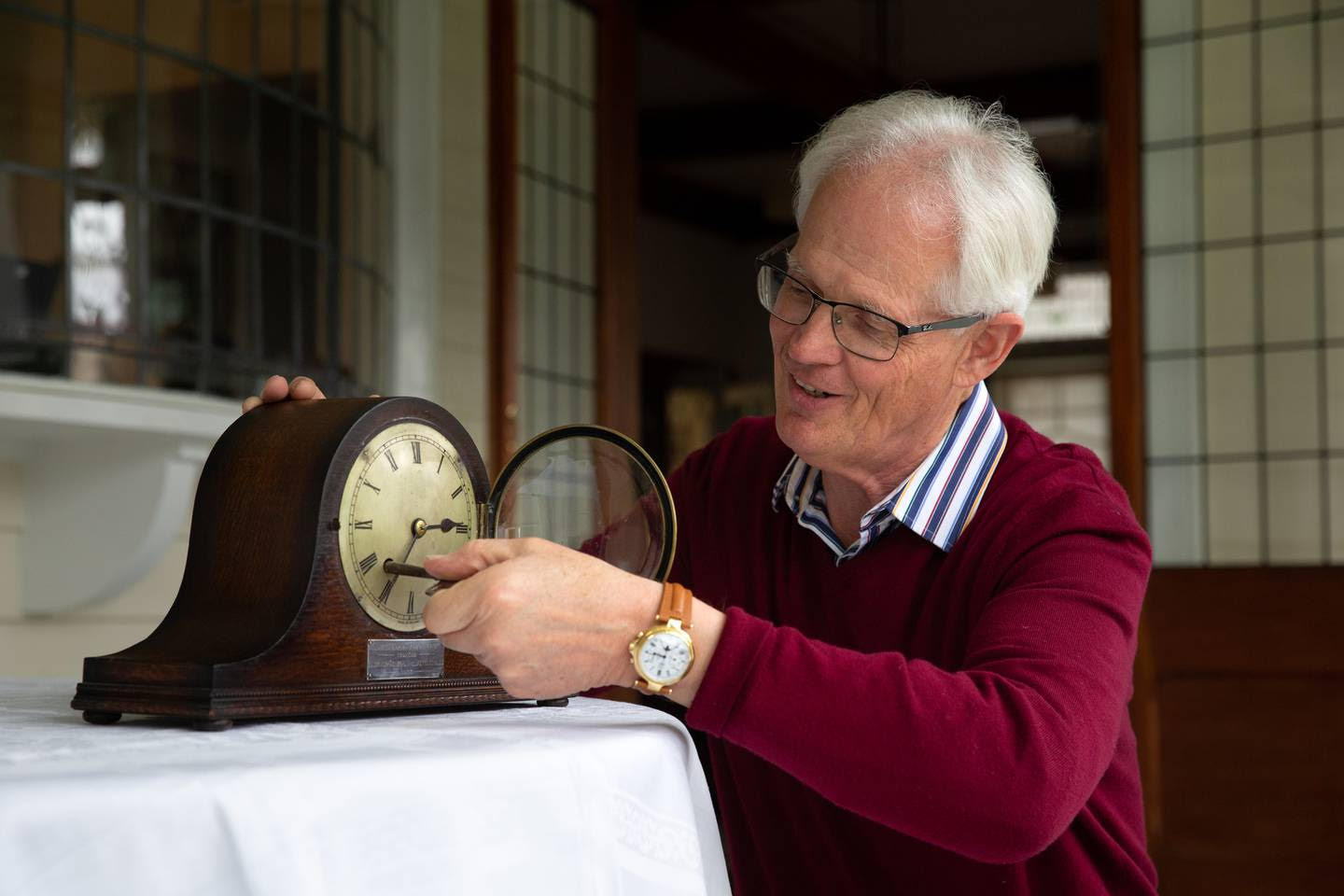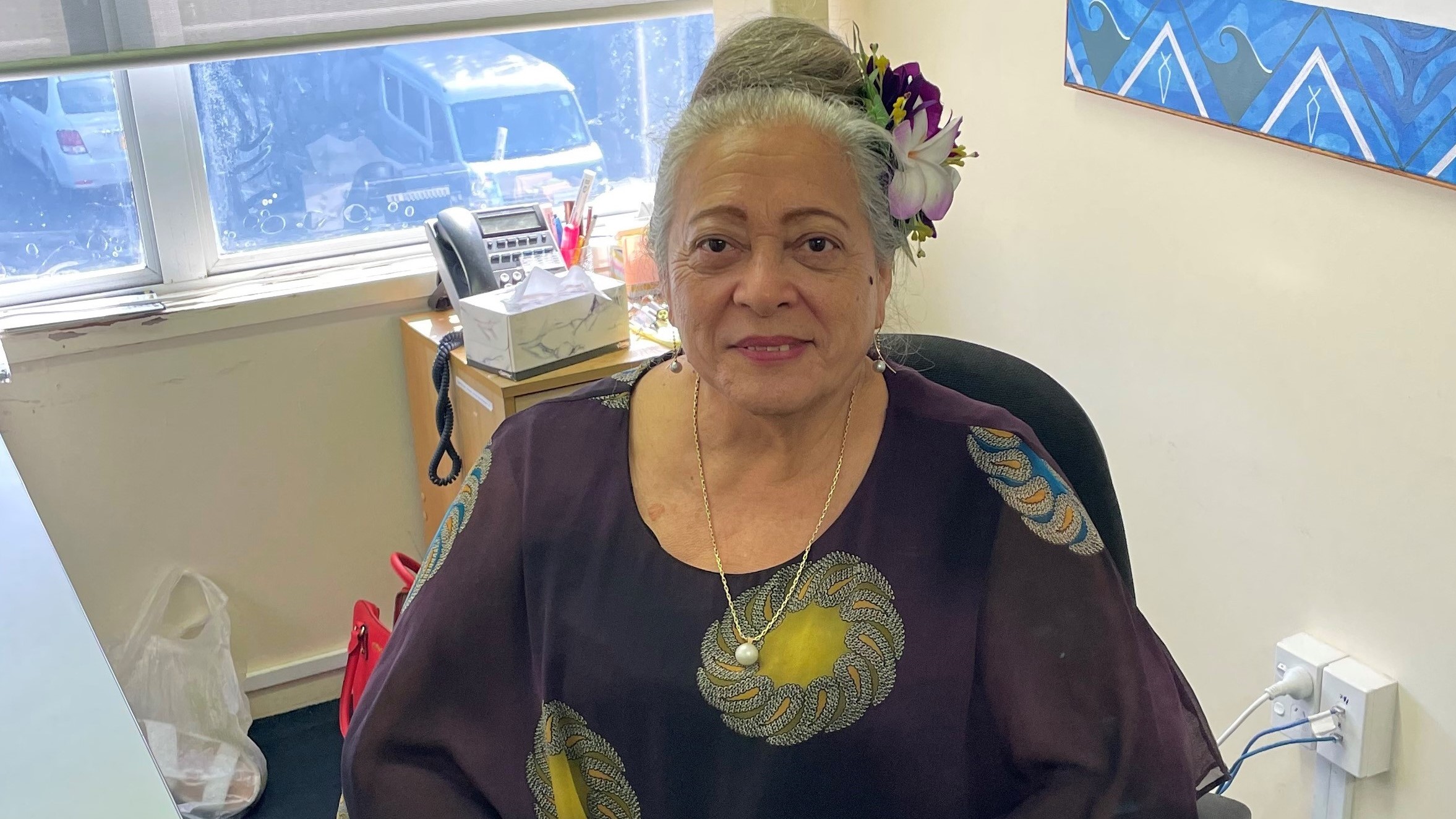The return of the Bledisloe clock
Tuesday 18 July 2023 | Written by Supplied | Published in Economy, National

Simon Crispe winds the Bledisloe clock every week to make sure it chimes every 30 minutes. Photo / Sylvie Whinray / 23071704
Senior journalist Jane Phare has contacted Cook Islands News and reports a precious timepiece will soon be returned to Rarotonga, in this story she unravels the mystery of the Bledisloe clock.
It's been a conundrum for more than 50 years – who owns the handsome clock presented to a Cook Islands chieftainess in 1933 by Lord Bledisloe, then Governor-General of New Zealand.
Auckland architect Simon Crispe, who will be watching the Bledisloe Cup final at home tonight, has spent years pondering the mystery of the handsome English "Empire" clock he was given on his 50th birthday. It was the engraved silver plaque attached to the art-deco Napoleon's hat-style oak case that intrigued him.
"Makea
Karika Takau Ariki from the Governor General and Lady Bledisloe 1933," it
reads.
Crispe, now 67, wanted to return the clock to the family and asked the Herald
to help track down descendants of Makea Karika Takau, originally known as Takau
Tuaraūpoko Mokoroa ki Aitū before she took the title.
As a result of that search, delighted Karika relatives in Rarotonga are now looking forward to the return of their noble forebear's clock to the family home, Ngarurutu Palace in Avarua, the Cook Islands capital.

Makea Karika Pā George in 1934. Photo / Alexander Turnbull Library
23071703
When the current title holder, Makea Karika George Ariki, was told by the Herald of the clock's existence he said it was "wonderful" news. "It is a gift I would really appreciate, especially from Lord Bledisloe. It will help us remember our past, our grannies."
The clock's history had been lost in the passing of time and the family had no idea how or why it ended up in New Zealand.
The Makea
Karika lineage history received a blow in the mid-1980s when the original
palace burned down in a fire. The flames took generations of memorabilia,
official photographs, historic treasures and gifts so there was little of the
original history left. If the Bledisloe clock had not been taken to New
Zealand, it too would have been likely destroyed in the fire.
George Ariki, 77, lives in the rebuilt palace and says on its return the
Bledisloe clock will be given a place of honour in the formal sitting room
where meetings are held. His cousin, Ian Karika, one of Makea's
great-grandsons, told the Herald the family would be pleased to have the clock
returned to Rarotonga and invited Crispe to visit the island.
He overhauled the clock until it was once again chiming every half hour and on the hour. But no one came to collect it and Crispe tried unsuccessfully to track down the owners. So the clock stayed in his shop for the next 28 years until, in 1987, he closed the business and retired.
Still bothered by who owned it, Crispe contacted the Papatoetoe police to ask what he should do. The police gazetted an item about the clock in a local newspaper for several weeks and eventually told Crispe, who died in 2013, the clock was now legally his.
Since inheriting the timepiece, Simon Crispe has kept the clock at his Auckland home, including during a lengthy stint working in the Middle East, now winding it weekly to make sure it still chimes. He too is delighted the clock will eventually be returned to the Cook Islands once arrangements are in place.
"It shouldn't be with me. I only have it because no one collected it," he says. "There was no internet back when my dad was trying to find the owner."
A vice-regal visit
Research shows the clock was a gift made during a vice-regal visit to Rarotonga in April 1933. A Press Association item, radioed from the New Zealand frigate HMS Diomede, tells of Lord and Lady Bledisloe's party leaving the island after being detained "by slight mechanical trouble which necessitate repairs".
The previous
morning the Governor-General had visited Karika, described as "an
important chieftainess and descendant of a famous war-like family". The
report said
Karika presented Lord Bledisloe with "beautiful mats and other
gifts". In return, she received presents from Lord and Lady Bledisloe,
among which would have been the engraved clock.
"There was a large gathering of natives as Karika has a considerable following and influence," the report said. "The visit to the island has been most successful. The cordiality manifested could not have been exceeded."

Dame Margaret Makea Karika Ariki (second from left) with the New Zealand Governor-General Anand Satyanand and his wife Susan with members of the Cook Islands House of Ariki in 2007. Photo / Supplied23071702
A noble family
Karika came from a long line of noble leaders, taking on public roles and attending community events on behalf of the islanders. She made land available to the Crown for public purposes and government buildings in Avarua.
When Karika died in 1942, the title was passed to her son, Makea Karika Pā George, a distinguished WWI soldier. He volunteered for the New Zealand (Māori) Pioneer Battalion and joined the New Zealand Expeditionary Force, serving in Egypt.
He was promoted to sergeant and, after the Battle of Jerusalem, was awarded the Distinguished Conduct Medal "for conspicuous gallantry and devotion to duty while in command of a platoon".
On Pā George's death in 1949, the title was passed to his daughter 29-year-old Margaret, who was 14 when Lord Bledisloe gifted the clock to her grandmother
Margaret, later Dame Makea Karika Takau Margaret Ariki, honoured her grandmother's land agreements, contributing forestry land to help create the 155-hectare Takitumu Conservation Area.
Affectionately known as Mama Karika, she had a life-long commitment to conservation and the environment and held many leadership roles, work that was acknowledged in the 2012 New Year Honours list when she became a Dame Commander.
Dame Margaret was considered a national icon in Rarotonga, serving for 68 years until her death in 2017 which was marked by a state funeral. Now her nephew, conservation veteran Ian Karika, works tirelessly helping to manage the reserve, trapping predators to protect endangered birds.
The Governor-General and the Bledisloe Cup
Lord Bledisloe, also known as Charles Bathurst, was well thought of during his time as Governor-General of New Zealand between 1930 and 1935. During a visit to Waitangi in 1932, Lord and Lady Bledisloe realised the significance of the then neglected 1834 treaty house and the surrounding land.
They bought the property and 404ha of adjacent land, presenting it to the nation in May 1932 as a national memorial. They also donated funds towards an appeal to restore The Treaty House where British Resident James Busby had once lived with his family.
Lord Bledisloe supported various causes and events, often donating a trophy. It was in 1931 that he presented the huge silver trophy that was the Bledisloe Cup, representing one of the greatest transtasman sporting rivalries. In 1933 he presented The New Zealand Chess Federation with the Bledisloe Cup for an annual chess tournament.
Lord Bledisloe also contributed to the national recognition of the Māori King movement, developing a friendship with King Korokī and Te Puea Hērangi. He presented trophies for art, gardens featuring New Zealand plants, and the Ahuwhenua Trophies, similar in size to the Bledisloe Cup, for excellence in Māori farming. He died in 1958, aged 90.
Footnote: Jane Phare writes, Simon Crispe and his wife Marianne are bringing the clock back to Rarotonga next month.
“Ariki George is delighted to have the clock back and I think there is some sort of handover ceremony planned. Simon has since taken the clock apart and, with skills learned from his horologist father, has cleaned and polished all the parts so the clock is in good working order.”



















































